Learn how to make 34 historical types of seams. For historical costumes and modern clothing!
The Victorians had a seam for every purpose! The following 34 historical types of seams have already been used since the Victorian era. While some types of seams are even older and have been used since the Middle Ages. You can use the following 34 historical seam finishes for your Victorian and Edwardian clothing. But of course you can also use them for your modern clothing!
What Type Of Seam Should I Use For My Sewing Project?
Choose a seam that is suitable for your sewing project. Some types of seams create a bulkier seam and are more suited for thin fabrics. While other types of seams help to stiffen the garment if you want to make a rather structured garment. Here’s a guide as to which type of seam was used for which sewing project in the late Victorian and Edwardian era:
- underwear: felled seams, French seam
- corsets: lapped seam, flat felled seam
- light summer dresses: decorative seams with lace inserts, handsewn seams (faggoted seam, picot seam, rolled seam, hemmed fell), flat felled seam
- tailored garments like wool skirts: flat felled seam, bound seam, tuck seam, slot seam, cord seam, overcast seam, pinked seam
- silk dresses: pinked seam, bound seam
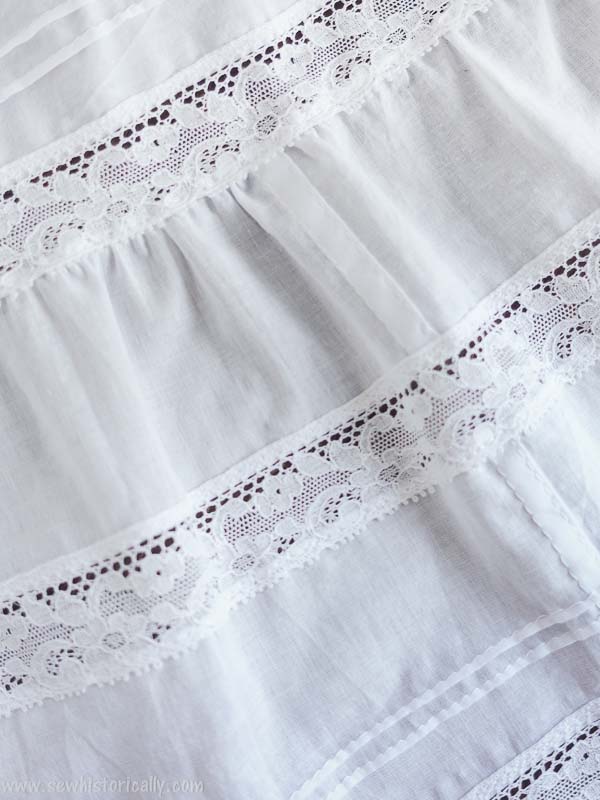
15 Closed Seams – Seams Without Visible Raw Edges
Closed seams have the raw edges encased in the seam: so there are no visible raw edges on the right or wrong side of the fabric.
Flat Felled Seam Aka Stitched Fell
The flat felled seam is my favorite seam for historical and modern clothing. In the past, the flat felled seam was usually called stitched fell because this type of
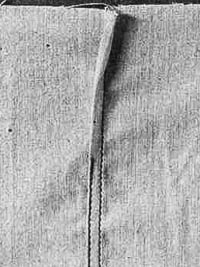
seam was sewn on a sewing machine. Place the pieces of fabric wrong sides together so that one of the seam allowances is twice as wide as the other. Sew a plain seam. Then fold the wider seam allowance inwards and over the other raw edge so that both raw edges are enclosed. Sew another line parallel to the first stitching line.
‘A stitched fell is a tailored seam. A plain seam is sewed on the right side. One edge is trimmed narrower than the other. The seam is laid flat and basted and stitched down to the material.’ (A Manual Of Home-Making, 1919) ‘This seam […] may be made on straight or bias material.’ (A Sewing Course For Teachers, 1893)
Hemmed Fell
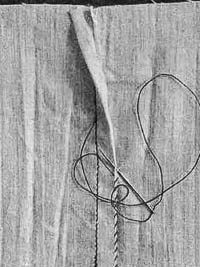
The hemmed fell – aka run and fell – is a type of felled seam. It’s made like a flat felled seam except that the second line of stitching is sewed with hemming stitches (overhand stitches) by hand.
‘A hemmed fell may be used in handmade garments. A plain seam is made on the wrong side. One edge is trimmed narrower than the other, and the wider edge is creased over the narrower. The seam is then laid flat and the folded edge hemmed down to the material.’ (A Manual Of Home-Making, 1919)
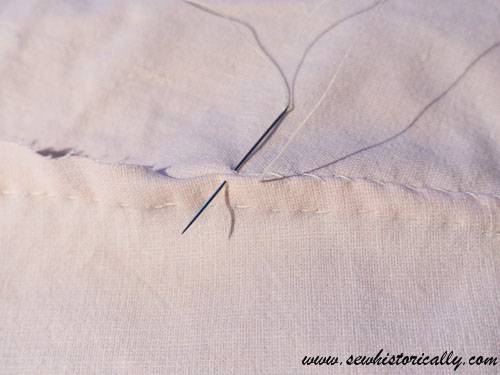
English Fell
The English fell is like a hemmed fell except that the seam allowance is folded before sewing.
‘This is really a plain fell, differing principally in the method of turning and sewing the first part. It is useful in making up sheer muslins, lawns, and similar materials where quickness of sewing rather than strength of seam is desired. […] Turn down the edge of one piece one-eighth of an inch on the right side. Place the raw edge of the other piece to this fold with the wrong side of each piece out. […] Sew with running stitches one-eighth of an inch below the lower edge. […] Press the turned edge down flat. Finish with hemming.’ (Home And School Sewing, 1901)
Overhand And Fell
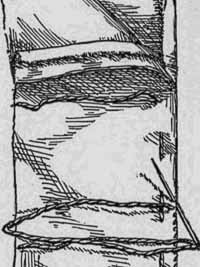
The overhand and fell seam – aka overseam and fell, reversible seam or counter seam – is like a hemmed fell except that the first stitching line is also made with overhand stitches.
‘The overhand stitch for the first sewing followed by the hemming stitch in the fell makes a very durable seam. Take the two pieces to be joined, turn a small fold on the raw edge of each piece – the turn on one piece should be twice as deep as the one on the other. Overhand the two pieces together, having the narrow fold toward the worker. Overhand the seams according to the rule for overhanding, press open the seam, turn the wide edge over the narrow and hem it down. The seam should be flat.’ (A Sewing Course For Teachers, 1893)
Lapped Seam
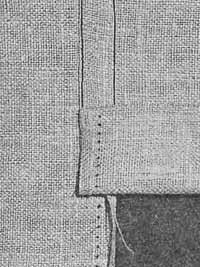
The lapped seam – aka German fell – looks like a flat felled seam when finished but it’s made differently. It’s the typical seam of historical corsets but it’s more difficult to sew than the flat felled seam.
‘It is made on the right side […] turn up the edge of one piece of the material about 1/8″ and turn down about 1/8″ on the edge of the piece to which it is to be joined. Lap the two seams 1/4″ to 1/2″ […] Stitch on the right side […] stitching close to the edge of the material placed on top. Stitch as near the edge of the other as you can from the right side, but be careful to keep the two rows of stitching parallel, even though the second row does not stitch the edge of the under lap as evenly as it does the upper one.’ (School Sewing Based On Home Problems, 1916)
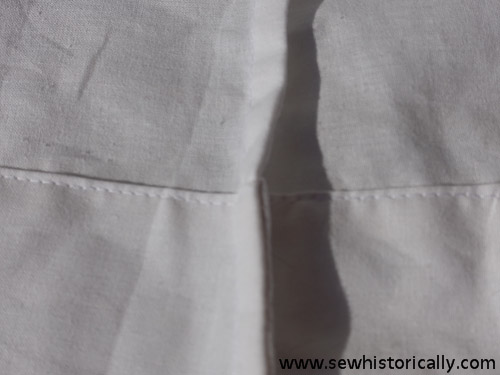
French seam
The French seam – aka French fell or standing fell – is an alternative to the flat felled seam. I prefer flat felled seams to French seams because flat felled seams are less bulky, easier to iron and drape better in my opinion.
‘The seam is to be twice sewed. […] Use a fine running stitch for the first sewing and make the seam as narrow as possible for strength. Trim the edges neatly, and lay the seam open with the finger nail. Turn the seam inside of the muslin, and make a new seam over the other on what will be the wrong side of the garment. […] The second sewing must cover the raw edges of the first seam.’ (A Sewing Course For Teachers, 1893)
Overhanded French Seam (Mock French Seam)
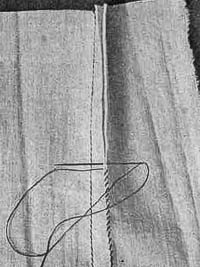
The overhanded French seam – aka overhanded fell or French fell – is another historical seam: It’s made like a plain seam. Then the raw edges are turned to the inside and the folded edges are stitched together with overhand stitches by hand (or with straight stitches on the sewing machine).
‘Overhanded or French fell same as hemmed fell, except the cloth is folded back on a line with the fold of the fell and over-handed as in French hem’ (Clothing For Women: Selection, Design, Construction, 1916).
Mantua-Maker’s Seam (Mock French Seam)
The mantua-maker’s seam looks a bit like a French seam on the wrong side of the fabric but it’s made completely differently. With right sides together, fold the raw edges together twice like a hem. Stitch close to the fold either with straight stitches on your sewing machine or with hem stitches (overhand stitches) by hand.
Rolled Seam
The rolled seam is an almost invisible seam for thin fabrics. Sew both raw fabric edges together into a rolled hem.
Overhand Seam
The overhand seam (butt seam) is an ancient seam finish, often used on handwoven linen
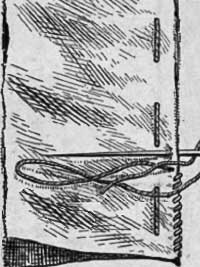
fabric. Sew two selvedges together with overhand stitches by hand. If there are no selvedges, finish the raw edges with a small hem and then sew both pieces of fabric together with overhand stitches. If there’s a lining, you can also finish all pieces so that the raw edges are enclosed between the outer fabric and lining and then sew the pieces together using overhand stitches.
‘Overhanding is done by sewing closely over two edges of cloth. The edge of the cloth may be either a selvedge or a creased fold.’ (School Needlework, 1893)
English Stitch Seam
This seam was popular in the 18th century – today it’s known as English stitch. It’s similar to the antique or old German seam (see below for details) but the English stitch seam can only be used if there’s a lining. Fold the seam allowances of the lining and outer fabric inwards so that the raw edges are enclosed between the lining and outer fabric. After preparing both pieces of fabric in this way, place all four layers of fabric on top of each other so that the outer fabric is with right sides together. Then sew the seam using the old German stitch: only include three of the fabric layers in your stitch at a time (the outer fabrics in each stitch and alternating one of the lining fabrics:
‘The mode of sewing these four thicknesses so as to make them lie flatly when opened, is rather peculiar. Take up with your needle, three of the thicknesses, leaving the fourth unsewed. The next stitch, take again three folds, leaving the other outside one unsewed: continue alternately taking up one side and omitting the other, letting the stitches lie close together: when completed, open the seam, and flatten it with the finger and thumb.’ (The Workwoman’s Guide, 1838)
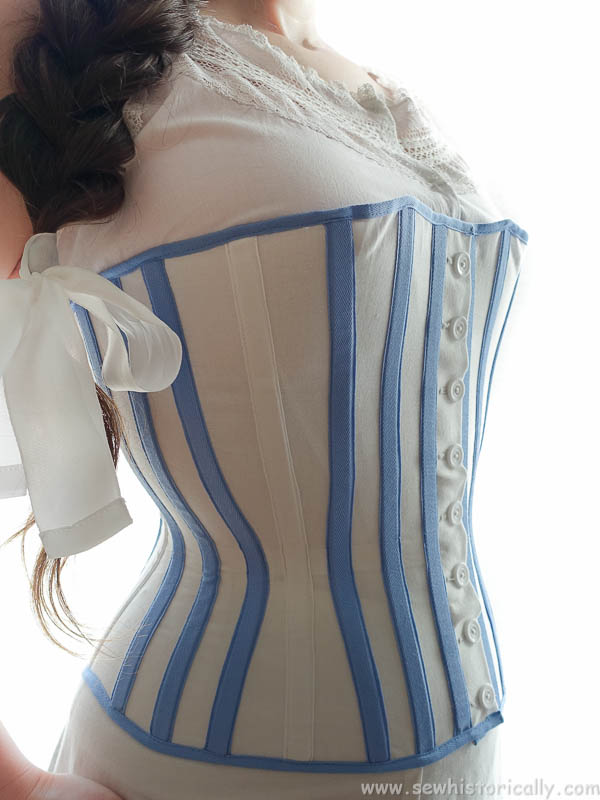
Strap Seam (Taped Seam)
With wrong sides together, sew a plain seam. Press the seam open. Then cover the raw

edges on the right side of the fabric with twill tape or bias binding.
‘Strap seams are plain seams over which straps of the material are stitched for ornamental purposes. The strips for these straps may be cut lengthwise of the material from pieces that are left after cutting out the garment, but […] when silk is used it is better to cut them on the bias’ (The Dressmaker, 1916).
Slot Seam
The slot seam is like a reverse strap seam.
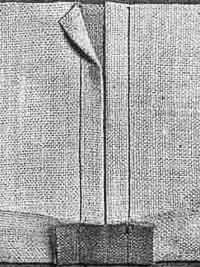
Sew a plain seam, then press it open. ‘Then baste an understrip of the material a trifle narrower than the combined width of the seam edges, directly under the basted seam. From the right side, stitch three-eighths of an inch on each side of the center. Remove the bastings. The turned edges, now free, give the slot appearance, whence the name.’ (The Dressmaker, 1916)
Double-Stitched Slot Seam
The double-stitched slot seam is a variation of the slot seam with two rows of stitching on each side of the slot seam.
‘A double-stitched slot seam is produced by stitching another row each side of the center close to the turned edges.’ (The Dressmaker, 1916)
Bound Seam
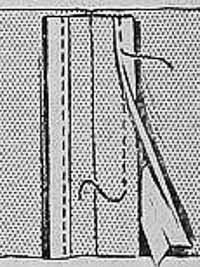
The bound seam is an elegant seam. In the past, it was often used on tailored garments. Sew a plain seam, then bind the raw edges together or separately. The raw edges of the seam are either bound with bias binding or straight grain binding (like twill tape).
‘Seams may be bound with the two parts of the seam together, or they may be pressed open and bound separately. This may be done with a bias strip, binding ribbon or tape. […] Trim and press the seam open. Double the binding ribbon through the center and crease. Place the raw edge of the seam to the fold of the ribbon and run along the edge, catching through to the under fold.’ (Sewing – Handicraft For Girls, 1918)
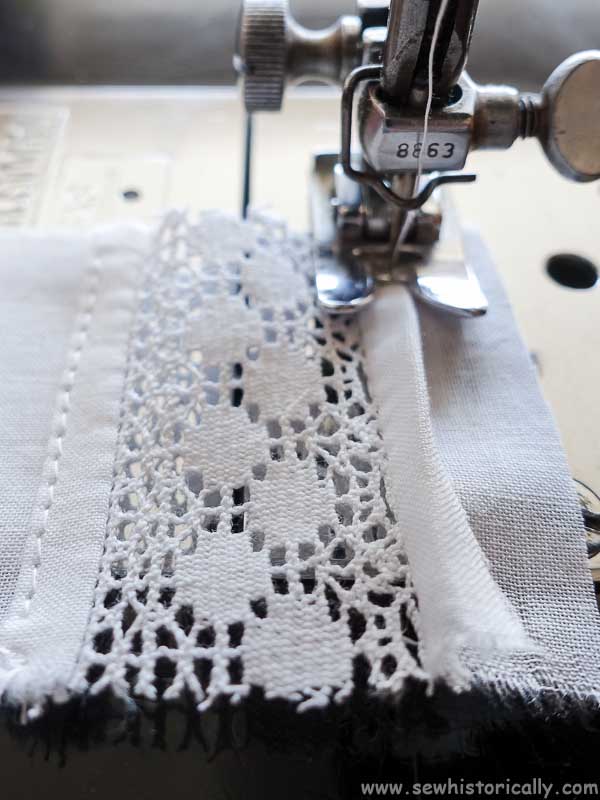
3 Decorative Seams Without Visible Raw Edges
In the past, decorative seams without visible raw edges were often used for special occasion dresses like summer lace dresses. Today they are almost never used because they often involve hand sewing and therefore take a lot of time.
Seam With Insertion Lace
To make a seam with lace inserts, insert the lace and finish the raw edges with a plain hem or a hand-rolled hem. For more details, click on the link below.
Related: 6 Ways How To Insert Lace
Faggoted Seam
Faggoted seams were popular in the Edwardian era and the 1920s. To make a faggoted seam, finish the raw edges with a plain hem or any other kind of hem. Then join the two fabric pieces with faggoting stitches by hand.
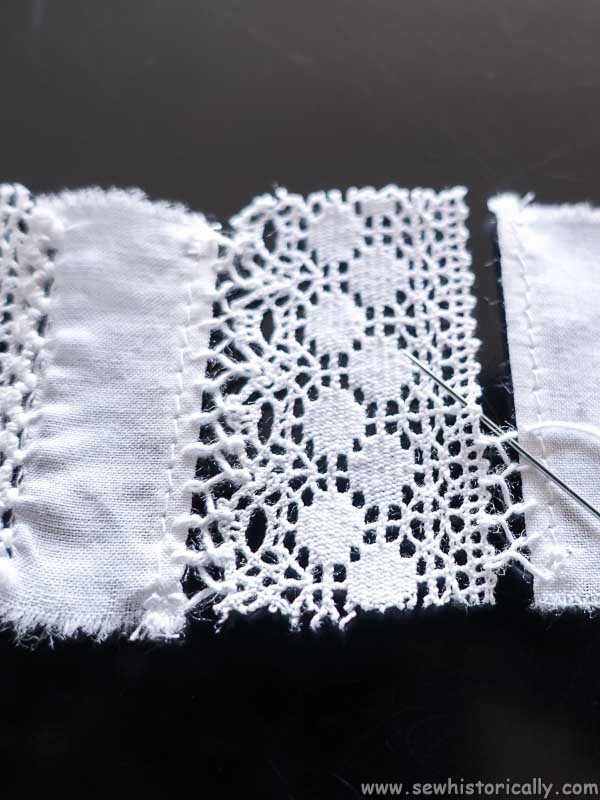
Picot Seam
The picot seam was especially popular in the 1920s for lightweight summer dresses. It was made on a special picot machine. Unless you can find an antique hemstitch machine, you can’t do this type of seam at home. You can’t use modern hemstitch & picot attachments for sewing machines because they don’t make a true picot seam and the seam is not strong enough.
Related: What’s A 1920s Picot Hem?
16 Open Seams – Seams With Visible Raw Edges
In contrast to closed seams, open seams are faster to sew and are therefore more often used in sewing projects and store-bought clothing. Open seams have visible raw edges on the wrong side of the fabric.
Plain Seam
The plain seam is the easiest of all seams. With right sides together, stitch the two pieces of fabric together and finish the raw edges with zigzag stitches. Note that in the past the raw edges of plain seams were never finished with zigzag stitches: instead the raw edges were usually either overcast or bound.
‘The edges of a plain seam may be overcast, bound, or opened, turned under, and stitched […] or a plain seam may be opened and each edge catch-stitched down to the garment.’ (A Manual Of Home-Making, 1919)
Pinked Seam
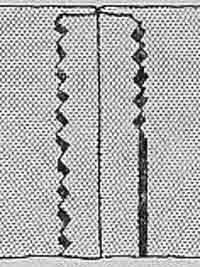
The seam is like a plain seam except that the raw edges are finished with pinking sheers. In the past, this type of seam was often used on felted wool fabric that doesn’t fray easily. Instead of pinking shears, they used pinking machines.
‘In plain seams of very closely woven material that does not fray or ravel, the edges of the seams may be simply notched or pinked, and pressed open.’ (The Dressmaker, 1916)
Serged Seam
This type of seam is also like a plain seam except that the raw edges are finished with a serger. I haven’t found a reference yet that serged seams have been used in the past.

Overcast Seam
Also a type of plain seam with the raw edges finished with overcast stitches by hand. It was a popular seam in the Edwardian era, particularly for tailored garments and fabrics that don’t fray much. After sewing a plain seam, finish the raw edges – either separately or both
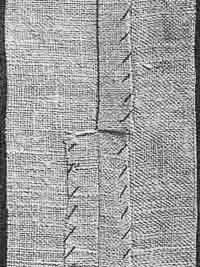
raw edges together – with overcast stitches. If there’s a lining, you can also sew the raw edges down to the lining using overcast stitches.
‘The overcast seam consists of an ordinary seam with the raw edges overcast to prevent raveling. […] Press open the raw edges and overcast each edge separately […] or leave the two edges together and overcast both at the same time […] This seam is used on heavy linen, wool, and silk materials where it is desirable to have the seam show as little as possible.’ (School Sewing Based On Home Problems, 1916)
Double-Stitched Seam
The double-stitched seam is like a plain seam with a second line of straight stitches to prevent fraying. I often see this type of seam on clothing made in India.
Plain Seam With Raw Edges
In the Victorian era, the edges of plain seams were sometimes left raw even though the fabric frayed easily. Whereas in the Edwardian era, only the edges of felted wool fabrics that didn’t fray were left raw.
Flannel Fell
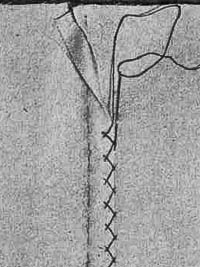
The flannel fell is a type of felled seam. In the past, this type of seam was used for flannel fabrics. It’s made like a flat felled seam except that the second line of stitching is sewed with catch stitches (herringbone stitches) by hand.
‘The flannel seam is used on material so thick that it is necessary to finish over a raw edge’ (Sewing – Handicraft For Girls, 1918). ‘A flannel fell is used in flannel garments. A plain seam is sewed on the wrong side. One edge is trimmed narrower than the other. The seam is laid flat and the raw edge catch-stitched down to the material.’ (A Manual Of Home-Making, 1919)
Welt Seam (Mock Flat Felled Seam)
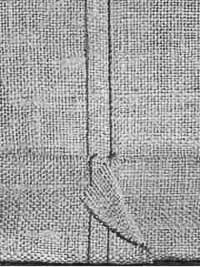
A welt seam looks like a flat felled seam on the right side of the fabric but the raw edges of fabric are not enclosed! The welt seam is easier and faster to sew than a true flat felled seam that’s why welt seams are often used on mass-produced clothing like jeans.
‘First stitch the seam as a plain seam […] turn seam toward front of skirt and baste close to the turned edge. Trim the edge of the seam next to the skirt narrower than the other and stitch again any desired width.’ (Clothing For Women: Selection, Design, Construction, 1916)
Double-Stitched Welt Seam
The double-stitched welt seam is a variation of the welt seam: It has two (instead of just one) stitching lines on the right side of the fabric.
‘A double-stitched welt seam has an additional row of stitching set in one-fourth inch or less from the edge.’ (The Dressmaker, 1916)
Top-Stitched Seam Aka Cord Seam
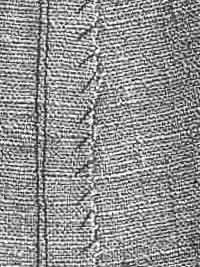
What is called a top-stitched seam today, was called cord seam or tailored seam in the Edwardian era. It was used for tailored wool skirts.
‘An ordinary tailored seam, which makes a good neat finish, is the plain seam pressed with both edges turned to one side, and a row of machine stitching run in neatly along the one side of the seam from the right side of the garment’ (The Dressmaker, 1916).
‘Stitch a plain seam, […] on the right side, stitch one-sixteenth inch from edge. Trim seam to five-eighth inch on wrong side and overcast edges together.’ (Clothing For Women: Selection, Design, Construction, 1916)
Double Top-Stitched Seam
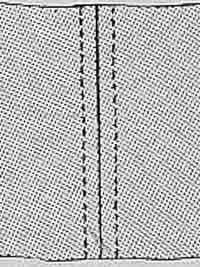
The double top-stitched seam is a variation of the top-stitched seam with a stitching line on each side of the seam.
‘A modification of the cord seam may be made by opening the plain seam and stitching close to the edges on both sides of the seam.’ (Clothing For Women: Selection, Design, Construction, 1916)
Tuck Seam Aka Open Welt Seam
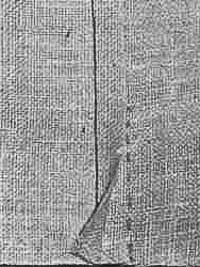
Another variation of the welt seam is the tuck seam aka open welt seam: It has a tuck-like fold on the right side of the fabric.
‘An open welt seam is first basted as for a plain seam. The tuck is then basted down, with the stitches directly over the line of bastings in the seam. With one row of machine stitching the tuck-like fold and the seam are made secure.’ (The Dressmaker, 1916)
‘Stitch only on the outside as far from the edge as may be desired. Use quilter gauge or presser foot as a guide in stitching. The edges are finished the same as a cord seam.’ (Clothing For Women: Selection, Design, Construction, 1916).
Corded Seam
The corded seam is made like a top-stitched seam except that you sandwich a cord between the layers of fabric before you sew the second line of stitching. The cord reinforces the seam.
Piped Seam
The piped seam is similar to the corded seam but you need a separate strip of fabric.
Cut strips on the bias, ‘place a cord along the centre of the strip, turn the material over it, push the cord well up into the fold, and run (through the double material) close under the cord.’ (Every Woman’s Encyclopaedia, 1910-2)
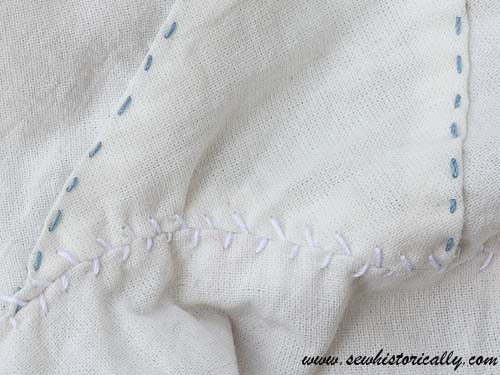
Old German Seam
This type of seam is very old: In the past, it was known as antique or old German seam. To make this seam, join the two pieces of fabric with baseball stitches by hand. By the way, in the Victorian era, the baseball stitch was called ‘antique seam stitch’ or ‘old German stitch’.
Hongkong Seam
The hongkong seam is a modern seam – I haven’t found a reference yet that it has been used in the past. The hongkong seam is made like a bound seam except that the bias binding is folded under only once so there are raw edges.
Please Pin It!
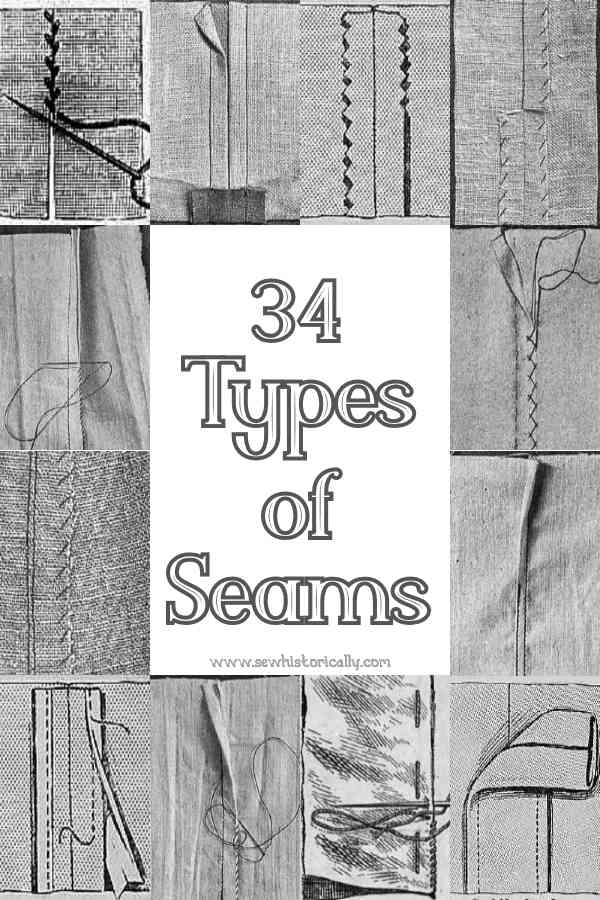
Oh I say! Thank you! That was incredibly perfect timing (for me); I was just looking for clear diagrams of some seam finishes this morning, to refresh my memory, and then up pops your post! Much obliged, and a very useful overview!
Yay! 😀 Glad it was helpful!
Totally love this post. Historical and practical all at once. More please. Write a book even! I would buy it! Include all the stuff you need in one place, like types of fabrics, pros and cons, uses etc. Tricks for mending or making fabric go further. Cutting and pinning tips and so forth!
Thank you so much for your lovely comment! And thanks for the idea! 😀